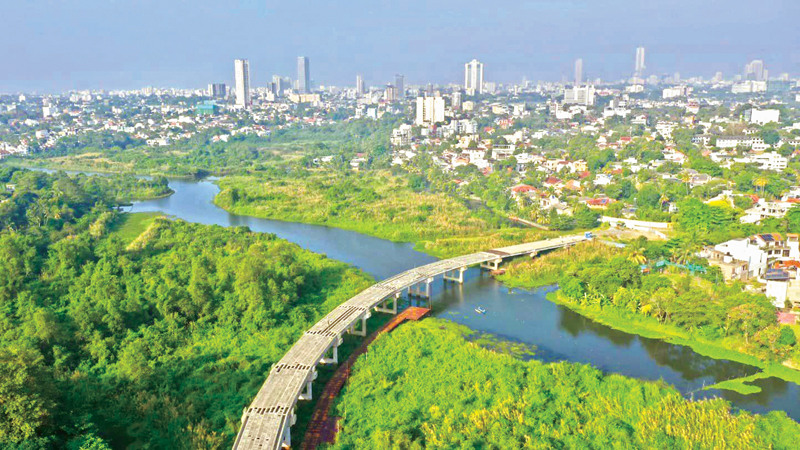- Bypasses Nugegoda
- Multiple entry and exit points
- Environmental-friendly
For a nation’s development to go ahead, it requires well-developed sectors in education, health, and transportation, particularly highways. Despite achieving high literacy rates and other excellent indices, our country has long grappled with the inadequate state of its highways. Efforts to implement highway and flyover projects have frequently encountered financial and other obstacles, leading to delays and setbacks. One such example is the Nawala – Angampitiya flyover route, which has faced significant challenges, further hindering progress in the transportation sector.
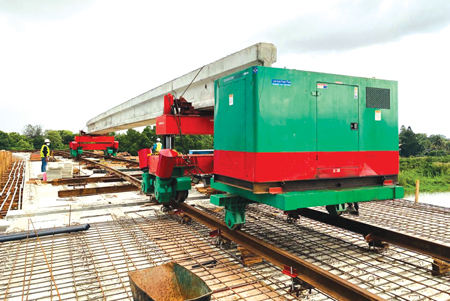
Special equipment brought by the Malaysian contractor to transport concrete beams
During the 2019/2020 period, the initiative spearheaded by then-President Gotabaya Rajapaksa commenced, despite facing opposition from certain politicians in the area. Among the false narratives propagated by them was the claim that constructing a road linking Kotte and Narahenpita via Nawala-Angampitiya was unsuitable due to the area’s environmental sensitivity.
However, they may have not been aware that the intended route for this road was to be constructed as an elevated thoroughfare over the Kolonnawa Canal. Rs. 1,500 million was allocated for the construction of the bridge, which began with the implementation of a specialised concrete transport road utilising pre-cast concrete beams, reflecting the latest technological advancements in construction.
However, construction work on the bridge was halted due to the onset of the Covid-19 epidemic. Despite significant investment and ongoing efforts to complete the project, construction on the bridge remained at a standstill for approximately four years thereafter. Only a fraction of the intended work had been accomplished, with installation remaining on an additional 60 concrete beams, equivalent to six rows of channels.
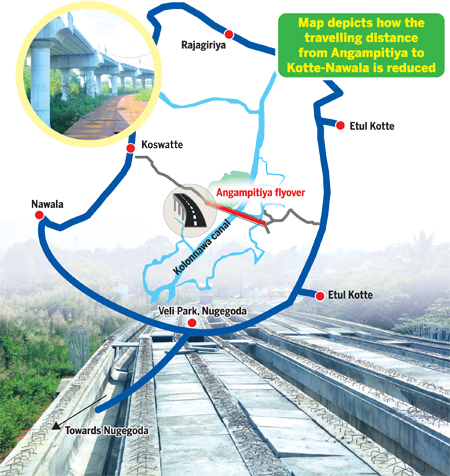 Colombo District Member of Parliament (MP), Madhura Withanage has repeatedly stressed the need to resume construction on the Nawala-Angampitiya bridge, which has remained in limbo for approximately four years. MP Withanage has been a staunch advocate for the bridge’s construction since its inception, demonstrating relentless dedication to the project despite facing opposition from certain politicians in the area.
Colombo District Member of Parliament (MP), Madhura Withanage has repeatedly stressed the need to resume construction on the Nawala-Angampitiya bridge, which has remained in limbo for approximately four years. MP Withanage has been a staunch advocate for the bridge’s construction since its inception, demonstrating relentless dedication to the project despite facing opposition from certain politicians in the area.
However, Minister of Transport, Highways, and Mass Media Dr. Bandula Gunawardena has now successfully secured approval from the Cabinet to allocate the remaining funds to accelerate the construction of the bridge.
An allocation of Rs.900 million has been earmarked in this year’s Budget to resume and complete the construction of the Nawala-Angampitiya bridge. This bridge, spanning the Nawala-Rajagiriya Canal (commonly known as the Kolonnawa Canal), will connect the Battaramulla-Pitakotte road with Nawala-Rajagiriya, addressing a vital transport need in the area. To mark the commencement of the final stage of construction, a group of officials, including Minister Dr. Gunawardena, recently conducted an inspection tour of the construction site.
Road connectivity
Following the inspection, the Minister directed officials from the Road Development Authority (RDA) and the State Development and Design Corporation (SD&CC) to expedite the remaining construction work on the bridge without any delay.
The bridge spans a length of 700 metres and boasts a width of 10.4 metres. Originally estimated to cost Rs.2,600 million, it serves as a critical infrastructure project aimed at enhancing road connectivity in the region.
The construction of this project, overseen by the RDA, is being executed by the SD &CC, a Government agency. This approach not only facilitates efficient project management but also helps save valuable foreign exchange that would otherwise be spent on outsourcing the construction work to foreign companies.
Chairman Kushan Devinda of the SD&CC said that the construction of this bridge will yield multiple benefits for the area and the country. “Some people may perceive building a new bridge as routine infrastructure development. However, bridges of this scale are typically constructed in urban areas to alleviate significant traffic congestion within the city. By doing so, we not only save valuable time for commuters but also reduce the nation’s reliance on imported fuel, thus conserving foreign exchange reserves.”
A prime illustration of this strategy is the construction of the ‘Marine Drive’ road, which runs parallel to the Galle Road and R.A. De Mel Mawatha (Duplication Road). “This road primarily serves light vehicles and is not designated as an approved bus route,” he said. Most motorists prefer to take this road sans traffic lights as traffic is minimal.
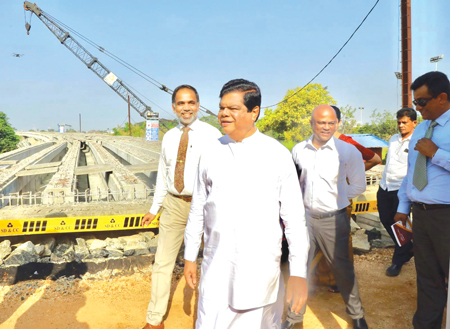
Minister Dr. Bandula Gunawardena, Colombo district MP Madura Vithanage and Chairman, State Development and Construction Corporation, Kushan Devinda inspect the construction work
“The necessity for the Nawala-Kotte road became evident due to the heavy traffic congestion experienced in areas such as Kotte, Battaramulla, Nawala, and Narahenpita, particularly during peak hours in the morning and evening. Reports assessing the traffic situation highlighted the pressing need for infrastructure improvements to alleviate this congestion effectively.”
“In response to these findings, the construction of the bridge was initiated to address the growing demand for improved transport networks in the area. The completion of major infrastructure projects such as the Southern Expressway and the Colombo Outer Circular Highway (OCH) has significantly impacted traffic patterns in the region. With increased connectivity and improved accessibility provided by these expressways, there has been a notable rise in vehicular traffic, particularly from areas around the Kottawa and Athurugiriya interchanges. As a result, areas like Battaramulla, Thalawathugoda, and Kotte have experienced heightened traffic volumes, especially from vehicles travelling at higher speeds exiting these interchanges,” he said.
“The completion of the Angampitiya Bridge is expected to significantly alleviate traffic congestion in the area. Once the bridge is operational, commuters will have an alternative route to access Narahenpita from Kirimandala Mawatha via Nawala School Lane,” he said.
“The construction of the Nawala-Angampitiya bridge, designed as the longest flyover in the area, relies entirely on pillars for support. This construction method ensures that minimal environmental damage occurs during the building process. Specifically, the bridge’s construction over swamps is carefully planned to avoid any harm to the Nawala Canal (Kolonnawa Canal) or the surrounding lands.”
Aerial route
As an elevated structure, the bridge is built as an aerial route, which inherently minimises the environmental impact compared to ground-level infrastructure projects. This approach helps preserve the natural landscape and ecosystems while still addressing the region’s transport needs. Overall, the construction of the bridge prioritises environmental sustainability and aims to minimise any adverse effects on the surrounding environment,” he elaborated.
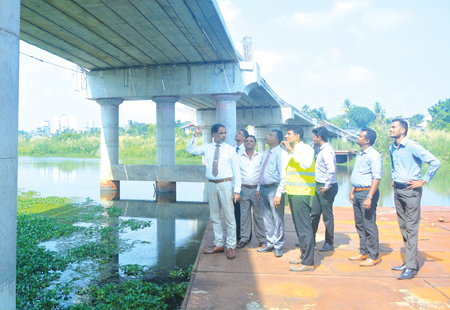
Chairman, State Development and Construction Corporation,
Kushan Devinda instructs officials on construction work
“The construction of the bridge will indeed provide convenient access to the Angampitiya entrance from both directions. With two entry points, one can enter from either side and exit from the other side, facilitating a smoother traffic flow and reducing congestion. Similarly, there will be two access points to School Lane (Nawala) offering flexibility for commuters to choose the most convenient route based on their destination.
This dual-entry system will help distribute traffic evenly and improve overall efficiency in navigating the area. By providing multiple entry and exit points, the bridge enhances connectivity and accessibility for commuters, ultimately contributing to a more streamlined and hassle-free transport experience,” he said.
On February 8, a brief ceremony was organised under the patronage of Minister Dr. Bandula Gunawardena to recommence work on the bridge project. MP Withanage, along with several other dignitaries, also participated.
The Minister, while overseeing the resumption of construction, initiated discussions to ascertain further requirements for expediting the completion of the bridge. Addressing the gathering, the Minister said that the construction of this bridge was initiated as part of a sustainable, environmentally friendly transport plan devised by former President Gotabaya Rajapaksa, who had previously helmed a project to beautify Colombo.
“As the Minister responsible for overseeing the project, I have personally visited this site on numerous occasions. I have observed the progress and the challenges faced in completing the final phase of this project. I told President Ranil Wickremesinghe that failing to finish this project is not just a delay or an inconvenience—it is a significant detriment to the progress and development of our nation,” he said.
Final stages
“The program aimed at reaching agreements with the relevant countries and international organisations for the repayment of debts, spearheaded by the President’s administration, the Ministry of Finance, and foreign experts, has now reached its final stages. Upon its successful completion, we will be in a position to resume all other development projects that were previously halted due to financial constraints,” he said.
“In this year’s Budget, the President, who is also the Finance Minister, has allocated Rs. 900 million to finalise the construction of this bridge. With this funding in place, the construction of the last stage of the bridge has commenced. We are on track to complete the project and open the bridge to the public by the end of next July. However, achieving this milestone requires the continued support and contribution of all stakeholders involved,” the Minister said.
Translated by Maneshka Borham
Pix By Sudath Nishantha



